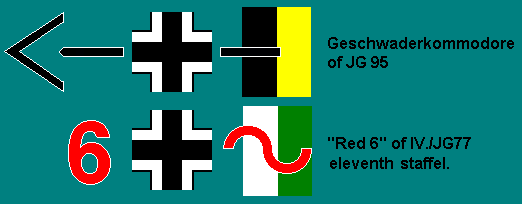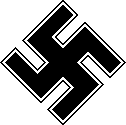German Fighter Aircraft Markings |
||||||||||||||||||||||||||
 JG-26 by Jay Thompson |
||||||||||||||||||||||||||
The painting above is typical of how Luftwaffe aircraft were painted in the early years of the war. The aircraft shown are Bf-109Es, or Emils (pronounced AY-MIL). The "S" in the shield was the emblem for this Geschwader which was known as "Schlageter". The nickname is derived from the name of a martyred German patriot. The number "12" in back identifies the pilot as Joachim Möncheberg of 7./JG-26, third group. The white band on the rear fuselage is typical of fighter aircraft serving in the Mediterranean. 7./JG-26 was stationed in Italy to lend support to the Italians and the Afrika campaign. The markings on the nearest 109, and the "Mickeymaus" emblem below the canopy, indicate that this aircraft belonged to Adolf Galland. The markings and color schemes are described in more detail below.
German fighter units were organized into Jagdgeschwader (fighter squadrons). Each Jagdgeschwader was broken down into four Gruppen (groups), which in turn were divided into three Staffeln (wings). Each Staffel was then made up of three Ketten (flights) which operated with 3 aircraft. There was also a Jagdgeschwaderstab (staff) of 4 aircraft (a 4 aircraft section was called a Schwarm), and a Gruppenstab with 3 aircraft each for every Gruppe. Thus, a Jagdgeschwader had an planned strength (Sollstarke) of 124 aircraft. Understandably, this number was hard to maintain. The organization is shown below: |
||||||||||||||||||||||||||
|
||||||||||||||||||||||||||
In the table above the roman numerals represent the Gruppen, while the arabic numerals represent the Staffeln. The colors for each staffel are listed to the right. The numerals and group markings were painted in these colors. In 1944 and later the Gruppen would be expanded to include a fourth Staffel and was assigned blue as its color.
The fighters carried a colored band on their rear fuselage to indicate their assigned theater of operations. Prior to 1944 fighter aircraft in Scandinavia, Russia and the Mediterranean were marked with a white band around the aft fuselage. In 1944 the Luftwaffe found itself being pulled back to Germany to perform home defense (Reichsverteidigung). The following color bands were adopted in 1944:
Early in the war Luftwaffe fighters were identified by the yellow engine cowlings, wingtips and tails. As the Germans began to lose air superiority they began to minimize the amount of yellow painting. Later only the undersides of the engine cowling would be painted yellow, or not at all.
Within every Jagdgeschwader a set of identifying symbols (kennzeichen) were used to identify the members. Below are some representative examples:
|
||||||||||||||||||||||||||
 |
The double chevron (winkel) was standard for Kommodore (Commodore) markings, but variations were wide spread. The inner chevron was sometimes smaller than depicted here, or was replaced by a solid triangle as the second example shows.
The vertical bar behind the chevrons was on occasion painted horizontally and given a point. The point may have been imbedded into the inner triangle. These markings were used by Werner "Vati" Mölders.
In some cases the second chevron disappeared all together. Adolf Galland's 109 was thus adorned. Other variations of these markings removed point from the horizontal bar.
Josef "Pips" Priller's Fw-190 was painted without the chevron and appeared as the example at left. Some variations placed a small rectangle in front of, or atop the left most horizontal bar. |
|||||||||||||||||||||||||
 |
These are examples of the Geschwader Ia (operations officer) Markings. |
|||||||||||||||||||||||||
 |
The first two examples show typical markings for the Geschwaderadjutant. The second conforms to the standard. |
|||||||||||||||||||||||||
The next two examples represent the Staff Major (Major beim Stab). The first conforms to the standard. |
||||||||||||||||||||||||||
The Geschwader Technische Offizier had a circle painted before the cross. The size of the circle varied in size and was sometimes painted as a solid circle. |
||||||||||||||||||||||||||
 |
The Kommodore typically flew with a staff flight (Stabschwarm) of 4 aircraft. These markings were typical of those seen on the staff aircraft. The numbers may have denoted the members seniority within the Schwarm (the literature is a little vague on this point). |
|||||||||||||||||||||||||
 |
||||||||||||||||||||||||||
Gruppenkommandeur (Group Commander) markings did not have the vertical or horizontal bars between the chevrons and the Balkankreuz. The first example depicted conformed to the standard. The second example was the second most prevalent. The third example was relatively rare. A fourth variation was similar to the first example, but put a third chevron inside the second. Gruppenstab officers also carried a symbol aft of the Balkenkreuz identifying the squad they belonged to (see example below). |
||||||||||||||||||||||||||
This is the marking of the Gruppenadjutant. |
||||||||||||||||||||||||||
The group also had a Technical officer. As with the Geschwader TO, the Gruppen TO had a cirlce which may have varied in size, or may have been painted as a solid circle. |
||||||||||||||||||||||||||
 |
The first group of the Geschwader had no special mark. The marks seen here are for the second (top), third (middle) and fourth (bottom) groups. These markings were painted in the colors of the Staffel within the group and were often times outlined in a contrasting color (white or black). |
|||||||||||||||||||||||||
 |
||||||||||||||||||||||||||
The above samples are not, necessarily, historically correct, but are technically correct as they might appear on fighter aircraft after 1943. Prior to 1943 the Reichsverteidigung (Reichs defense) wasn't used. With the appearance of the "Dicke Autos" (literally: Fat Cars), or heavy bombers, the Jagdwaffe began a program of painting the spinners black with white spirals (or other geometric patterns). The strategy here was to create an optical effect which would be distracting to the gunners and minimze their effectiveness. How well this worked is a matter of debate.  The Hakenkreuz ("hooked cross"), or SWASTIKA, was the symbol of the NAZI (NAtional SoZIalist -- a short form for Nationalsozialistische Deutsche Arbeiter Partei, or NSDAP) party. It has also become synonymous with hate, terror, and tyranny. However, its origins have a more pious root. Adolf Hitler was a choirboy in the Catholic church he and his family attended. Above the alter hung an icon with a similar cross painted on it. It is believed that Hitler stylized this symbol of Christianity, and adopted it as the symbol of his NAZI movement. A second, but less likely, source may be Nordic (and Norse) mythology. Thor, the Nordic god of war and thunder, was symbolized as four lightning bolts radiating from a common point.
Close this window to return to the main page Copyright © 1998-2025, 486th Bomb Group Association. |
||||||||||||||||||||||||||